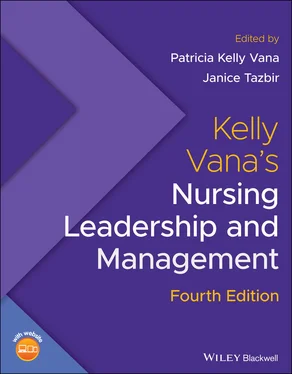African American women during these times did not have the opportunities open to Whites. Nurses' training was rarely open to Black women in White hospitals and, likewise, the fledgling professional nursing organizations were not open to Blacks in all parts of the U.S. Thus, the leadership of such women as Martha Franklin, who graduated as a nurse in 1897, is all the more impressive. In 1907, Franklin, an African American graduate of the nurse training school of the Women's Hospital of Philadelphia, personally wrote 1,500 letters to Black nurses throughout the United States asking about forming a society. In 1908, 52 Black nurses met in New York and founded the National Association of Colored Graduate Nurses. Franklin was the first president. At the close of the first meeting, Lillian Wald invited the women to the Henry Street Settlement House for lunch and to offer support and mentorship (Keeling et al., 2018).
Lillian Wald was among those nurses who established another significant nursing organization, the National Organization of Public Health Nurses. In 1911, a committee, formed of members of the American Society of Superintendents of Training Schools for Nurses and the Nurses Associated Alumnae of the United States and Canada, met to standardize the field of public health nursing. They wrote to over a thousand organizations that employed public health nurses and, at the 1912 meetings of the two organizations held in Chicago, the public health organization was formed (Kandel, 1920). Wald, considered to be the founder of public health nursing, became the first president (Keeling, et al., 2018). It is instructive to appreciate how important public health nursing was at this time. We might think that nurses mainly worked in hospitals prior to quite recently—but they didn't. Nurses have been actively involved with public health, working to promote health and support home care, for centuries. In terms of leadership, these pioneers who founded early nursing organizations deserve our respect for their imagination and sense of purpose. Today, nursing organizations present a rich source of support for all nurses. Many nurses join a general national organization, such as the ANA, as well as one that is specific to their nursing specialty.
The following Table 3.1lists just a few of the scores of national nursing professional organizations, beginning with the oldest, the American Society of Superintendents of Training Schools for Nurses.
Table 3.1 Professional Nursing Organizations Compiled by B. Lusk
| Year founded |
Organization |
| 1893 |
American Society of Superintendents of Training Schools for Nurses—now the National League for Nursing |
| 1896 |
Nurses' Associated Alumnae of the United States and Canada—now the American Nurses Association |
| 1908 |
National Association of Colored Graduate Nurses—merged with the American Nurses Association in 1951 |
| 1912 |
National Organization of Public Health Nurses—merged with the National League for Nursing in 1951 |
| 1922 |
Sigma Theta Tau International Honor Society of Nursing—now Sigma |
| 1931 |
American Association of Nurse Anesthetists |
| 1941 |
American Association of Nurse Midwives—merged with the American College of Nurse Midwives in 1969 |
| 1952 |
National Student Nurses Association |
| 1955 |
American College of Nurse‐Midwives |
| 1967 |
American Organization of Nurse Executives |
| 1969 |
American Association of Colleges of Nursing |
| 1971 |
American Assembly for Men in Nursing |
| 1971 |
National Black Nurses Association, Inc. |
| 1978 |
American Association for the History of Nursing |
| 1985 |
American Association of Nurse Practitioners |
| 1995 |
National Association of Clinical Nurse Specialists |
The possibilities and the problems we confront in our daily work raise new questions that we look to documents in our archives to answer. Our generation wonders how groups of nurses influenced broader movements of social change, transforming their lives as well as those of their patients and communities, and created opportunities and aspirations that took them beyond the health care system itself.
Patricia D'Antonio, PhD, RN, FAAN
Carol E. Ware Professor in Mental Health Nursing
Director, Barbara Bates Center for the Study of the History of Nursing
University of Pennsylvania School of Nursing
Philadelphia, Pennsylvania.
Adah Belle Thoms graduated from the Lincoln Hospital School of Nursing in 1905, a New York City school only for Black students, although under White administration. During the First World War, nurses volunteering for war service joined the American Red Cross but Black nurses were rarely accepted. Only during the last month of the war, in the fall of 1918, were 24 Black nurses called up. Meanwhile, 22,000 White nurses had been accepted. Seeing the futility of trying to volunteer, Thoms set up an organization of Black nurses called the Blue Circle Nurses, which was associated with the recently founded Circle for Negro War Relief. These nurses functioned as public health nurses for needy Black families. In 1929, Thoms was appointed the first Black Assistant Superintendent of Nurses at Lincoln Hospital. That same year, Thoms' book, Pathfinders , the first account of prominent Black nurses, was published (Clark Hine, 1989).
Consider why Black patients, nurses, medical, and ancillary staff needed Black hospitals during the late nineteenth and early twentieth centuries.
Thoms was a remarkable early nurse leader, as evidenced by her organization of the Blue Circle Nurses, her administrative work, and her book, all accomplished within the context of rampant racism. Can you identify some leadership qualities she might have possessed to support her in accomplishing all this?
Professional Nursing Matures
Nursing education was, in some respects, a victim of its own success. Nursing students were both superior to untrained women and cheaper than graduate nurses. Nursing students were highly disciplined and compliant young women who could work longer and harder than nursing employees at a fraction of the cost. Nursing students were expected to work at least 8 hr a day and then spend time preparing for classes. In most schools, students worked more than 48 hr a week on day duty and, in about 40% of schools, they worked over 70 hr a week on night duty (Committee, 1934, p. 166). Disturbingly, most of the nursing superintendents in the mid‐1920s preferred student nurses rather than graduate nurses to give patient care. Some of their reasons were: “The student nurse is less apt to be careless in technique, gives better cooperation in regard to hospital regulations, is less extravagant with hospital linen and supplies, and with the help and advice of an experienced supervisor, gives her patients care equal to that of the graduate”… “Graduates on general duty are demanding, exacting, and shifting” (Burgess, 1928, p. 412).
The 1920s and 1930s: Evolving Hospital Nursing
The nurse training period in the 1920s was typically 3 years. This time was mainly spent working within different wards of the hospital and attending lectures after work. But this was not an apprenticeship. The students were the nurses for the hospital patients. They were not practicing under the direction of graduate nurses. A national study by the Committee on the Grading of Nursing Schools in the early 1930s found that two‐thirds of the schools did not have even one graduate nurse employed for bedside nursing (Committee, 1934, p. 180). Upon graduation, the new crop of nurses were given a diploma and left the hospital, mainly to work as nurses in private homes, while the hospital nurse training school admitted a new batch of students. Hospital administrators could not ignore the advantage of an unpaid nursing workforce and the number of nurse training schools mushroomed. In 1880, there had been 15 schools. In 1920, there were 2,155 schools (Burgess, 1928, p. 35). However, many of these new nurse training schools were situated in small or specialist hospitals, entirely unsuited to general nursing education. Furthermore, as noted earlier, African Americans were rarely accepted as students or nurses at White hospitals, while men were rarely accepted at any hospital or nurse training school. A few male only and African American only nurse training schools were founded; the latter also served as training and practice sites for African American physicians and other health care workers.
Читать дальше












